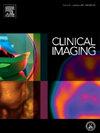Does ACR TI-RADS increase efficacy of thyroid ultrasounds?
IF 1.5
4区 医学
Q3 RADIOLOGY, NUCLEAR MEDICINE & MEDICAL IMAGING
引用次数: 0
Abstract
Background
The American College of Radiology Thyroid Imaging Results and Data System (ACR TI-RADS) is a risk stratification system (RSS) to assess ultrasounds of thyroid nodules. This study aims to evaluate if the implementation of ACR TI-RADS reduces fine needle aspiration cytology (FNAC) of benign nodules.
Material & methods
All patients diagnosed with a thyroid nodule, and who received an ultrasound between January 2018 and February 2020 were included. Period I included patients undergoing ultrasound before implementation of ACR TI-RADS and period II after implementation. The impact of ACR TI-RADS on the number of FNACs with the accompanying cytological results and guideline concordance were analyzed.
Results
In this study, 787 patients and 889 ultrasounds were included. Of these ultrasounds, 403 were performed in period I and 486 in period II. The proportion of ultrasounds leading to FNAC decreased significantly since implementation (51.6 % vs. 43.6 %, p = 0.018) while the proportion of benign cytology results decreased significantly as well (84.4 % vs. 73.6 %, p = 0.020). Furthermore, since ACR TI-RADS implementation, physicians followed the accompanying guidelines on follow-up in 70.4 % of the cases.
Conclusion
A decrease of FNAC of benign thyroid nodules was observed since implementation of ACR TI-RADS and this RSS was easily implemented in our clinic.
ACR TI-RADS能提高甲状腺超声的疗效吗?
美国放射学会甲状腺成像结果和数据系统(ACR TI-RADS)是一种评估甲状腺结节超声检查的风险分层系统(RSS)。本研究旨在评估ACR TI-RADS的实施是否会降低良性结节的细针穿刺细胞学(FNAC)。材料,方法纳入2018年1月至2020年2月期间接受超声检查的所有甲状腺结节患者。第一阶段包括实施ACR TI-RADS前接受超声检查的患者和实施后接受超声检查的患者。分析ACR - TI-RADS对FNACs数量的影响及相关细胞学结果和指南一致性。结果本研究共纳入患者787例,超声检查889张。在这些超声检查中,第一阶段有403例,第二阶段有486例。自实施以来,超声检查导致FNAC的比例显著下降(51.6%比43.6%,p = 0.018),良性细胞学结果的比例也显著下降(84.4%比73.6%,p = 0.020)。此外,自ACR TI-RADS实施以来,医生在70.4%的病例中遵循了随附的随访指南。结论应用ACR TI-RADS后,甲状腺良性结节的FNAC明显下降,且易于临床应用。
本文章由计算机程序翻译,如有差异,请以英文原文为准。
求助全文
约1分钟内获得全文
求助全文
来源期刊

Clinical Imaging
医学-核医学
CiteScore
4.60
自引率
0.00%
发文量
265
审稿时长
35 days
期刊介绍:
The mission of Clinical Imaging is to publish, in a timely manner, the very best radiology research from the United States and around the world with special attention to the impact of medical imaging on patient care. The journal''s publications cover all imaging modalities, radiology issues related to patients, policy and practice improvements, and clinically-oriented imaging physics and informatics. The journal is a valuable resource for practicing radiologists, radiologists-in-training and other clinicians with an interest in imaging. Papers are carefully peer-reviewed and selected by our experienced subject editors who are leading experts spanning the range of imaging sub-specialties, which include:
-Body Imaging-
Breast Imaging-
Cardiothoracic Imaging-
Imaging Physics and Informatics-
Molecular Imaging and Nuclear Medicine-
Musculoskeletal and Emergency Imaging-
Neuroradiology-
Practice, Policy & Education-
Pediatric Imaging-
Vascular and Interventional Radiology
 求助内容:
求助内容: 应助结果提醒方式:
应助结果提醒方式:


